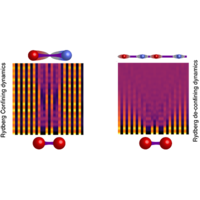当前位置:
X-MOL 学术
›
Phys. Rev. X
›
论文详情
Our official English website, www.x-mol.net, welcomes your feedback! (Note: you will need to create a separate account there.)
Lattice Gauge Theories and String Dynamics in Rydberg Atom Quantum Simulators
Physical Review X ( IF 12.5 ) Pub Date : 2020-05-21 , DOI: 10.1103/physrevx.10.021041 Federica M. Surace , Paolo P. Mazza , Giuliano Giudici , Alessio Lerose , Andrea Gambassi , Marcello Dalmonte
Physical Review X ( IF 12.5 ) Pub Date : 2020-05-21 , DOI: 10.1103/physrevx.10.021041 Federica M. Surace , Paolo P. Mazza , Giuliano Giudici , Alessio Lerose , Andrea Gambassi , Marcello Dalmonte

|
Gauge theories are the cornerstone of our understanding of fundamental interactions among elementary particles. Their properties are often probed in dynamical experiments, such as those performed at ion colliders and high-intensity laser facilities. Describing the evolution of these strongly coupled systems is a formidable challenge for classical computers and represents one of the key open quests for quantum simulation approaches to particle physics phenomena. In this work, we show how recent experiments done on Rydberg atom chains naturally realize the real-time dynamics of a lattice gauge theory at system sizes at the boundary of classical computational methods. We prove that the constrained Hamiltonian dynamics induced by strong Rydberg interactions maps exactly onto the one of a U(1) lattice gauge theory. Building on this correspondence, we show that the recently observed anomalously slow dynamics corresponds to a string-inversion mechanism, reminiscent of the string breaking typically observed in gauge theories. This underlies the generality of this slow dynamics, which we illustrate in the context of one-dimensional quantum electrodynamics on the lattice. Within the same platform, we propose a set of experiments that generically show long-lived oscillations, including the evolution of particle-antiparticle pairs, and discuss how a tunable topological angle can be realized, further affecting the dynamics following a quench. Our work shows that the state of the art for quantum simulation of lattice gauge theories is at 51 qubits and connects the recently observed slow dynamics in atomic systems to archetypal phenomena in particle physics.
中文翻译:

Rydberg原子量子模拟器中的晶格规理论和弦动力学
规范理论是我们理解基本粒子之间基本相互作用的基石。它们的性质经常在动力学实验中探究,例如在离子对撞机和高强度激光设备上进行的实验。描述这些强耦合系统的发展是经典计算机面临的艰巨挑战,它代表了对量子物理学现象进行量子模拟的关键性公开任务之一。在这项工作中,我们展示了最近在Rydberg原子链上进行的实验如何自然地在经典计算方法边界处的系统大小上实现晶格规范理论的实时动力学。我们证明了由强Rydberg相互作用引起的受约束哈密顿动力学恰好映射到U(1)晶格规理论之一。基于此对应关系,我们表明,最近观察到的异常缓慢的动力学现象与弦反转机制相对应,让人联想到规范理论中通常观察到的弦断裂现象。这是这种慢动力学的普遍性的基础,我们在晶格上的一维量子电动力学的背景下对此进行了说明。在同一个平台上,我们提出了一组实验,这些实验通常显示长寿命的振荡,包括粒子-反粒子对的演化,并讨论如何实现可调整的拓扑角,从而进一步影响淬灭后的动力学。我们的工作表明,晶格规理论的量子模拟技术处于51量子位,并将原子系统中最近观察到的慢动力学与粒子物理学中的原型现象联系起来。
更新日期:2020-05-21
中文翻译:

Rydberg原子量子模拟器中的晶格规理论和弦动力学
规范理论是我们理解基本粒子之间基本相互作用的基石。它们的性质经常在动力学实验中探究,例如在离子对撞机和高强度激光设备上进行的实验。描述这些强耦合系统的发展是经典计算机面临的艰巨挑战,它代表了对量子物理学现象进行量子模拟的关键性公开任务之一。在这项工作中,我们展示了最近在Rydberg原子链上进行的实验如何自然地在经典计算方法边界处的系统大小上实现晶格规范理论的实时动力学。我们证明了由强Rydberg相互作用引起的受约束哈密顿动力学恰好映射到U(1)晶格规理论之一。基于此对应关系,我们表明,最近观察到的异常缓慢的动力学现象与弦反转机制相对应,让人联想到规范理论中通常观察到的弦断裂现象。这是这种慢动力学的普遍性的基础,我们在晶格上的一维量子电动力学的背景下对此进行了说明。在同一个平台上,我们提出了一组实验,这些实验通常显示长寿命的振荡,包括粒子-反粒子对的演化,并讨论如何实现可调整的拓扑角,从而进一步影响淬灭后的动力学。我们的工作表明,晶格规理论的量子模拟技术处于51量子位,并将原子系统中最近观察到的慢动力学与粒子物理学中的原型现象联系起来。


























 京公网安备 11010802027423号
京公网安备 11010802027423号